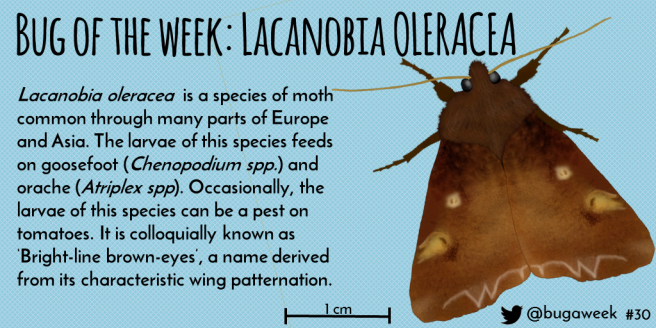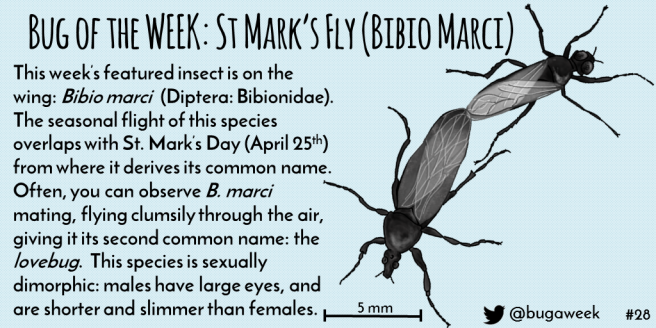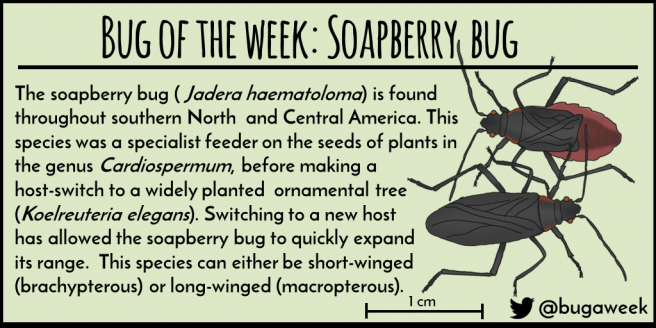
entomology
Bug of the Week: Lethocerus americanus
This giant water bug is this week’s feature. It is a chunky beast, often measuring more than 5-cm in length. Their close relatives are often eaten as a snack throughout many parts of the world.
This particular species was included in a piece I put together called ‘The Usual Suspects’ over at Buzz Hoot Roar. This site is the coolest graphical science blog around, do have a wander through their archives – so many great posts!

Bug of the Week: Bright-lines Brown-eyes

It’s getting to be that time of the year when a bedroom light and an open window can lead to an extra bit of entomology before drifting off to sleep. Earlier this week, I was treated to a visit by this pretty-little noctuid moth: Bright-lines brown-eyes (Lacanobia oleracea). I have many wonderful memories of moths flying about before bed, in particular my brother and I spotting luna moths (Actias luna) doing circles of the street lamp outside our window. This particular species isn’t quite as majestic as a luna moth, but definitely a lovely reminder that summer is on the way. It’ll be cockchafer (Melolontha melolontha) season next (Hooray!).
Best wishes,
P
Bug of the Week: Bibio marci
While doing a little impromptu bird-watching this weekend, Bibio marci paid me a visit. I figured it was only right to feature this short-lived species as bug of the week.

Guest Post at Buzz, Hoot, Roar

I’ve got some exciting news! One of the coolest science blogs out there (Buzz Hoot Roar), posted a piece I recently wrote. Buzz Hoot Roar is a graphics driven blog that explains a scientific concept in 300 words or less. The team is wonderful to work with: inordinately kind, professional, and very fun. If you have an interest in creating some sciart, and exploring a unique project in science communication – I would certainly recommend BHR. You can read the new piece (about arthropod species that tend to freak people out) here.
Bug of the Week: Two-Striped Grasshopper
 “The two striped grasshopper (Melanoplus bivattus) is widely distributed across North America. It is found throughout urban and rural habitats. When it reaches high densities this species may inflict agricultural damage. Its name comes from the two yellow dorsal stripes that run along the length of its body”
“The two striped grasshopper (Melanoplus bivattus) is widely distributed across North America. It is found throughout urban and rural habitats. When it reaches high densities this species may inflict agricultural damage. Its name comes from the two yellow dorsal stripes that run along the length of its body”
This is a species we grew up chasing all over the place. Like other orthoptera (crickets and grasshoppers), this species goes through incomplete metamorphosis: where a smaller grasshopper gets larger with each moult, eventually ending up with fully-functioning wings. My siblings and I grew up calling this species the ‘Big Mama’ grasshopper. Still a little unsure as to why that became a thing. But whenever I see this species, I think immediately ‘Big Mama’.
Paul
Bug of the Week: Aphodius erraticus
The bug of the week is Aphodius erraticus. This is a species I have used in experiments during my PhD, and is particularly endearing. Its elytra is a charming golden-bronze, with dark inner striae which almost gives the impression of an extra-long scutellum. This is one of the most common European species, and it can also be found in North America. It was inadvertently introduced across the pond in soil ballast, or perhaps from livestock dung on less than pristine ships.

Bug of the Week: Jadera haemotoloma

Jadera haematoloma is one of the many bugs included in the citizen science project ‘Bugs in Our Backyard’ (BiOB) – a programme based on monitoring different bugs (Hemiptera), run by Dave Angelini at Colby College. Jadera haematoloma is a particularly interesting bug, that has rapidly evolved alongside switching hosts. BiOB gives a wonderful overview of this bugs fascinating story here. On the BiOB website, there are also plenty of great resources for teachers, families, and individuals looking to get their hands dirty, and explore the interesting creatures creatures found in their own backyards.
Bug of the Week: Boreus borealis

Boreus brumalis can be found on sunny winter afternoons, when air temperatures approach zero degrees Celsius. You can find them in large numbers scuttling along the snow’s surface. Females have reduced wings that are barely visible. In contrast, the male has The elongate, hardened wings that are used for grasping the female in order to mate. Their mating position looks a little like the male is giving the female a piggyback.
For a nice review of the interesting lifecycle of this insect, check out this 1979 paper by JD Shorthouse.
Bug of the week: Pterostichus melanarius

This common ground beetle is widely distributed. It is a voracious predator with a varied diet which includes: springtails, earthworms, aphids, slugs, and flies. This species comes in two forms: a short-winged flightless (brachypterous), and long-winged flying (macropterous). Long-winged individuals play an important role in helping this species colonise novel habitats.
During my undergraduate years, I researched the ability of P. melanarius to control blueberry maggot infestations. Blueberry maggots develop within a single berry, leaving the berry to pupate within the soil. It is this stage when the pest is most most vulnerable to predation. In laboratory experiments, we found that addition of a single beetle was able to reduce the number of pupae between 40-80% relative to a control.
References:
